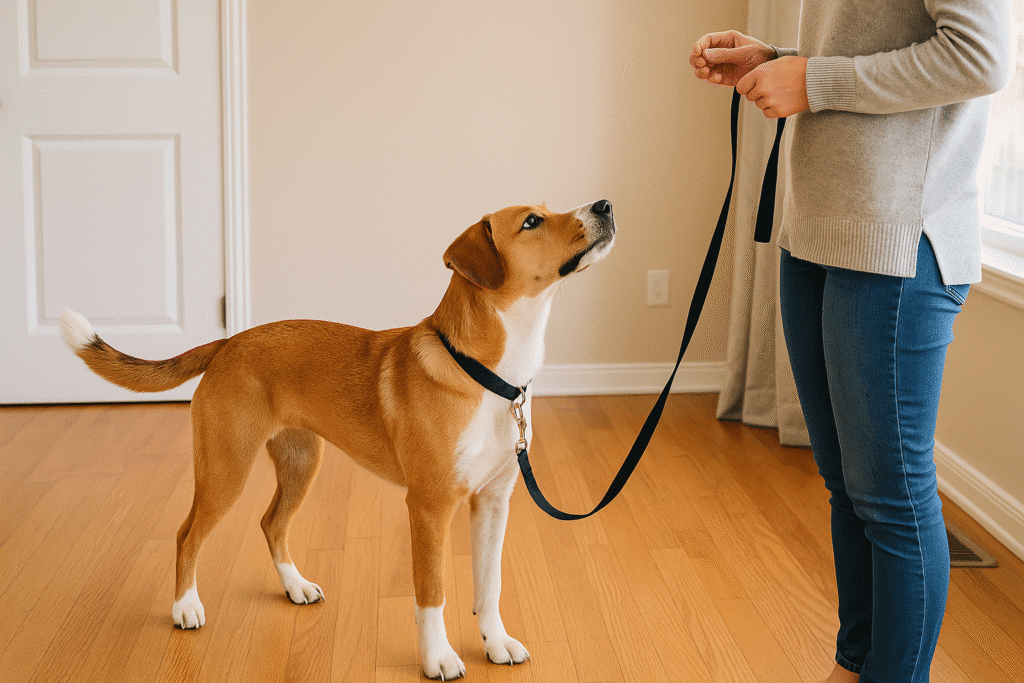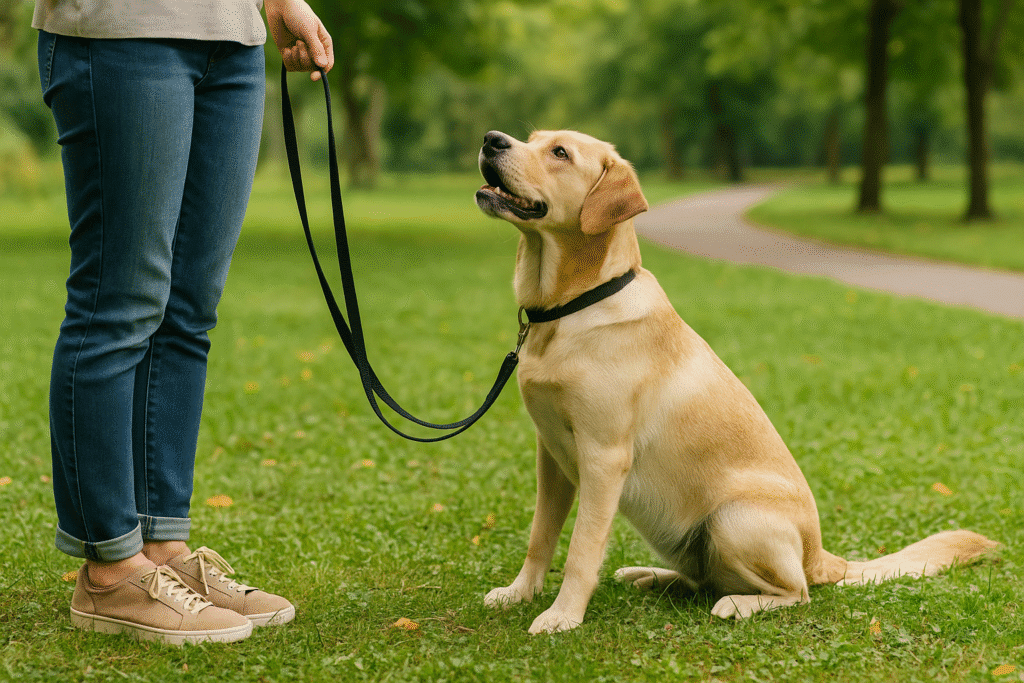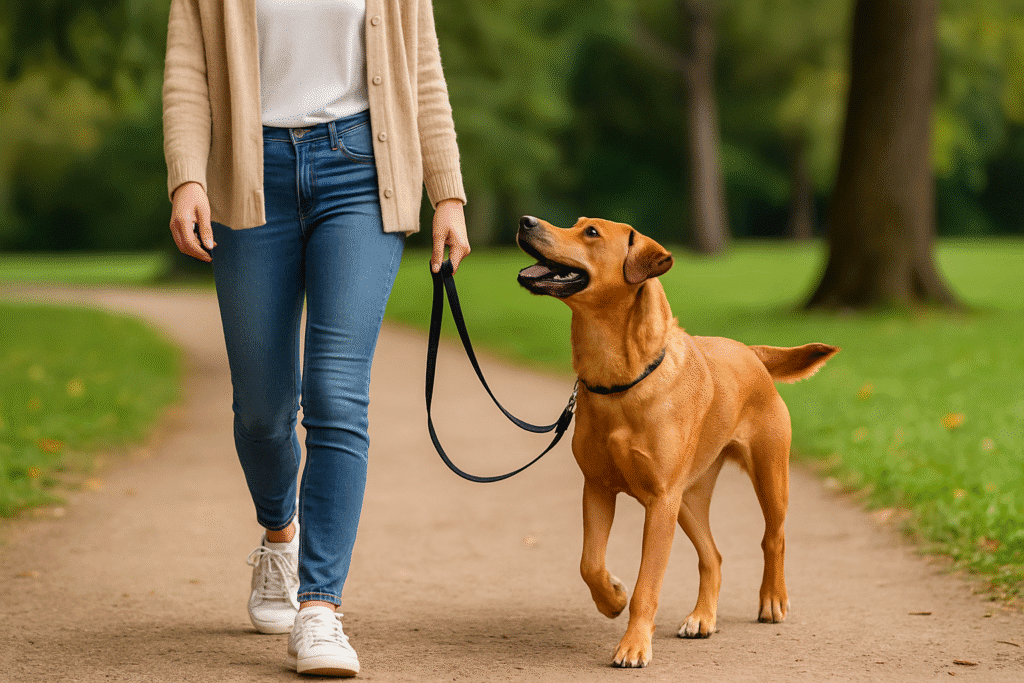This loose leash walking guide shows you step-by-step how to train your dog for calm, enjoyable walks. Learn effective methods, tools, and common mistakes to avoid so your daily walks become stress-free experiences for both you and your pup.
Introduction
Walking your dog should be a bonding experience, not a tug-of-war. Many owners struggle with leash pulling, but the good news is that with patience and the right techniques, your dog can master loose leash walking. This loose leash walking guide will help you achieve relaxed, happy walks together.
(Outbound link: For leash manners and loose-leash steps, see VCA Hospitals: Controlling Pulling on Walks (Loose Leash Walking).)

What Is Loose Leash Walking?
Loose leash walking means your dog walks calmly beside you without pulling or lagging behind. The leash remains slack, and your dog pays attention to your pace and direction. It is different from formal “heel” training, which requires stricter precision.
Why Is Loose Leash Walking Important?
- Safety: Prevents accidents and injuries caused by sudden pulling.
- Enjoyment: Walks become more pleasant for both you and your dog.
- Bonding: Builds communication and trust between you and your pet.
- Training foundation: Improves focus and responsiveness for other commands.
Preparing for Training
Before you begin loose leash training, gather the right equipment and set realistic expectations. Training takes time, especially for high-energy dogs.
Essential Tools
- A sturdy, standard-length leash (4–6 feet)
- A comfortable, well-fitted harness (front-clip works best for pullers)
- Plenty of small, tasty treats
- Clicker (optional, for clicker training)
(Internal link: For beginner-friendly gear, see our Puppy Training Tools Guide.)

Step-by-Step Loose Leash Training
Step 1: Start Indoors
Begin in a quiet environment free of distractions. Encourage your dog to walk by your side, rewarding them whenever the leash stays slack.
Step 2: Reward Eye Contact
Each time your dog looks at you, reward with a treat. Eye contact is key to building focus.
Step 3: Short Sessions Outdoors
Gradually move outside, starting in low-distraction areas. Keep sessions short—just a few minutes—and reward often.
Step 4: Use the Stop-and-Go Method
When your dog pulls, stop walking immediately. Only continue when the leash is slack. This teaches your dog that pulling gets them nowhere.
Step 5: Change Directions
If your dog pulls forward, turn and walk the other way. Reward when your dog follows you. This keeps them attentive and engaged.
Step 6: Add Duration and Distractions
Increase walk time gradually and introduce busier environments. Keep rewarding calm, focused walking.
Common Mistakes to Avoid
- Inconsistency: Allowing pulling sometimes and correcting at other times confuses your dog.
- Using retractable leashes: These encourage pulling.
- Lack of patience: Training takes time; rushing will only frustrate both you and your dog.
- Overlong sessions: Dogs learn best in short, positive bursts.
Natural Reinforcements Beyond Treats
While food rewards are effective, use other reinforcements too:
- Verbal praise and petting
- Access to sniff interesting spots
- Playtime after the walk
When to Seek Professional Help
If your dog’s pulling is severe or aggressive behaviors appear, consult a certified dog trainer. Professional support ensures safe and effective progress.
(Internal link: Learn more in our Recall Training Guide.)

Frequently Asked Questions (FAQ)
- How long does it take to train loose leash walking?
It varies, but with consistent practice most dogs improve within a few weeks. - What’s the difference between loose leash walking and heeling?
Loose leash walking is casual and relaxed, while heeling is precise and formal. - Can older dogs learn loose leash walking?
Yes, with patience, dogs of any age can learn this skill. - Do I need special equipment?
A front-clip harness and standard leash are recommended, but patience and consistency are most important. - What if my dog lunges at other dogs?
Practice redirection and consider professional help if reactivity is severe.
Conclusion
This loose leash walking guide demonstrates that with patience, consistency, and positive reinforcement, every dog can learn to walk calmly. A relaxed leash walk strengthens your bond and makes daily outings enjoyable for both owner and pet.
Call to Action
Want more training tips? Explore our Training Tips collection here.


핑백: Stop Dog Pulling on Leash in 3 Days: Simple Tricks for Stress-Free Walks